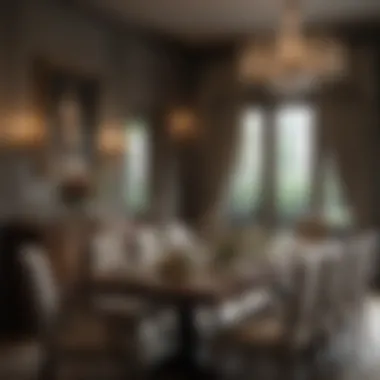Dining Room Inspiration: Design Ideas for Every Style


Intro
The dining room is often the center of our homes, where we gather for meals and special occasions. This space transcends mere function; it is a canvas for style and a backdrop for memories. Understanding how to create an inspiring dining room involves examining various elements such as styles, colors, and furnishings. With considerations for both aesthetics and practicality, this guide helps homeowners and design aficionados navigate their design journeys.
The discussion begins with design inspirations, which form the foundation of a well-crafted dining environment. Next, we’ll touch upon maintenance and upkeep strategies that keep the dining room looking fresh and inviting.
Design Inspirations
Design choices for your dining room can range from the modern to the traditional. Let’s explore some trending styles and effective color palettes.
Trending Styles
- Modern Minimalism: This style emphasizes simplicity and functionality. Clean lines and uncluttered surfaces create a serene dining experience. Furniture typically has a sleek design with an emphasis on light materials. Minimalism creates a peaceful atmosphere conducive to meaningful interactions.
- Industrial: Inspired by urban lofts, industrial design features raw elements like exposed brick, metal accents, and reclaimed wood. This style injects a sense of character and history into the dining space. Lighting fixtures often resemble factory designs that enhance the overall aesthetic.
- Scandinavian: This trend is appreciated for its warmth and comfort. Often characterized by light woods, soft textiles, and a neutral palette, Scandinavian design employs functionality and lack of excess. It promotes a cozy yet stylish dining experience.
"The beauty of a well-designed dining room lies in its ability to fuse function with expression, catering to your personal tastes."
Color Palettes
When choosing a color palette, consider the mood you desire to create. Here are some popular combinations:
- Warm Neutrals: Cream, taupe, and soft browns invoke a welcoming sensation. These colors pair well with natural wood tones.
- Bold Accents: Deep greens or royal blues can create a stunning contrast against lighter walls or furnishings. Adding colored tableware or artwork enhances this effect.
- Pastel Shades: Soft pinks, blues, and yellows offer an airy feel. These shades work well in light-filled spaces, inspiring tranquility.
Remember, the right colors can evoke specific emotions. Combining various shades thoughtfully can help you achieve your desired atmosphere in the dining room.
Maintenance and Upkeep
After establishing your dream dining room, regular maintenance becomes essential to preserve its appeal. Here are practical tips for upkeep.
Seasonal Maintenance Checklist
- Spring: Clean windows; dust lighting fixtures; consider refreshing fabrics (curtains, tablecloths).
- Summer: Remove debris; inspect furniture for damage; ensure proper ventilation.
- Fall: Deep clean hardwood floors; polish metal accents; check for any signs of wear.
- Winter: Brighten up with warm lighting; inspect any heating elements; organize to keep the space inviting.
Cleaning and Organization Tips
- Use microfiber cloths to wipe surfaces and minimize dust.
- Implement storage solutions for tableware and seasonal decorations.
- Regularly declutter to maintain the dining space’s functionality and attractiveness.
Understanding Dining Room Functionality
Dining rooms serve more than just a place to eat; they are focal points in homes that reflect style and relationship dynamics among family and friends. Understanding the functionality of a dining room is essential to creating a space that meets various needs while ensuring comfort and elegance.
Establishing a defined purpose for your dining room can significantly impact design decisions. A well-planned dining area facilitates not only daily meals but also gatherings, celebrations, and even work-from-home situations. It is important to consider the lifestyle of those who will use the space.
"A dining room is where experiences happen, transforming simple meals into meaningful memories."
A seamless blend of aesthetics and practicality is necessary. This balance becomes more pronounced when we look into the layout, furniture choices, and décor. Having an understanding of dining room functionality allows homeowners to make informed decisions that uplift the atmosphere and encourage interaction.
Defining the Purpose of Your Dining Room
Defining the purpose of your dining room may start by answering a few questions. Is this area primarily for family gatherings, hosting guests, or casual everyday dining? By pinpointing its function, you can tailor the space precisely to your needs.
For example, a dining room meant for large, festive gatherings will need a larger table and flexible seating arrangements, whereas a space for quick breakfasts may only require a small table and chairs. Several options arise from understanding the core purpose:
- Family dining: Comfortable seating and a central table that encourage discussion.
- Formal gatherings: Invest in finer chairs and table settings to accommodate entertaining.
- Casual use: Smaller tables can invite a cozy atmosphere.
- Multi-functional space: Allow for different layouts to switch from dining to work or socializing.
Considering these factors can lead to functional spaces that align with lifestyle needs.
The Balance Between Formal and Informal Spaces
Striking a balance between formal and informal settings in the dining room can add depth to your home design. Often, dining rooms exist on a spectrum of formality. An understanding of this balance can enhance your overall design approach.
In many households, the same space may switch roles depending on the occasion. For instance, a room might serve casual meals on weekdays but transform into a formal venue during family celebrations or holidays. To achieve this balance:
- Furniture flexibility: Choose tables and chairs that easily transition between formal and informal styles.
- Decor: Use aesthetic elements, such as lighting or tableware, to suit various occasions.
- Layout adjustments: Consider a layout that adapts well for both formal dinners and relaxed family meals.
By thoughtfully incorporating these aspects, the dining room can serve as a versatile area that celebrates both everyday living and special events.
Current Trends in Dining Room Design
In the dynamic world of interior design, dining rooms have evolved to reflect contemporary lifestyles and aesthetics. The focus on current trends in dining room design is crucial as it allows homeowners to create spaces that not only serve functional purposes but also resonate with modern design sensibilities. Understanding these trends can guide you in making informed choices about color, furniture, layout, and overall ambiance. The right design elements can elevate the dining experience, making it more enjoyable and memorable for gatherings.
Minimalism vs. Maximalism
The debate between minimalism and maximalism has been prominent in the design community. Minimalism values simplicity and understated elegance. Clean lines, neutral color palettes, and uncluttered spaces are hallmarks of this style. In dining rooms, a minimalist approach can create an atmosphere of calm and clarity. Furniture typically features sleek forms, such as a rectangular white table or light wood chairs without excess ornamentation. This trend is not just about aesthetics; it promotes a sense of order and space efficiency.
On the other hand, maximalism embraces boldness and diversity. It invites layering of colors, patterns, and textures. A maximalist dining room may showcase a rich tapestry of wallpapers, an eclectic mix of furnishings, and vibrant art. This style can make a strong statement, encouraging personal expression and creativity. However, it requires careful curation to avoid visual chaos. The essence of maximalism lies in creating a narrative through the arrangement of diverse elements that speak to the homeowner's personality.


Eclectic Styling in
2023 has seen a rise in eclectic styling that combines various design elements to create unique dining spaces. This approach resonates with homeowners who crave individuality and personal storytelling in their homes. Eclectic design bridges styles and cultures, allowing for the inclusion of vintage and modern pieces in one cohesive setting.
Key aspects of eclectic styling include:
- Mix and Match: Integrating contrasting elements can lead to surprising synergies. For instance, pairing a modern glass table with antique wooden chairs creates an intriguing dynamic.
- Personal Artifacts: Displaying personal items, like travel souvenirs, adds character to the dining room. These items often spark conversations, enriching the dining experience.
- Bold Experimentation: Colors and textures can be combined in unexpected ways. A bright patterned rug under a neutral table, for example, can add warmth and interest.
In summary, current trends in dining room design emphasize the importance of balancing personal taste with practical functionality. Minimalism and maximalism offer distinctive paths to achieve different atmospheres, while eclectic styling provides a canvas for personal expression. Understanding these elements allows homeowners and design enthusiasts to craft dining spaces that are not only visually appealing but also tailored to their lifestyle.
Color Schemes for Dining Areas
Color selection is crucial in creating the right atmosphere in any dining room. The color scheme sets the tone, not only for the room itself but for the experiences that are had there. Choosing the right colors can influence moods, enhance design elements, and complement furniture and decor. Homeowners and design enthusiasts alike should understand the significance of color schemes in transforming dining areas into spaces that are not only functional but visually appealing.
Understanding Color Psychology
Color psychology delves into how colors affect emotions and perceptions. Different hues can evoke various feelings. For instance, warmer colors like red and orange create an atmosphere of warmth and sociability, fostering conversation during meals. In contrast, cooler shades such as blue and green promote calmness and relaxation, making them ideal for a more serene dining experience.
When selecting colors, consider the purpose of the dining room. If it's primarily for intimate family dinners, a warm palate might enhance connection. For formal gatherings, neutral tones can create an elegant backdrop, allowing decor to flourish without overwhelming the senses.
Here are a few key psychological effects of colors to consider:
- Red: Encourages appetite and conversation.
- Blue: Calming, can suppress appetite.
- Yellow: Promotes happiness and cheerfulness.
- Green: Represents balance and harmony.
This insight into color psychology supports informed decision-making, enabling homeowners to select hues that resonate with their desired ambiance and functionality.
Trendy Color Palettes to Consider
Current trends in color palettes for dining areas reflect a blend of modernity and timeless elegance. When exploring options, it is essential to find palettes that not only appeal aesthetically but also work well with existing features in the room. Here are some trendy colors to highlight:
- Earth Tones: Shades of brown, beige, and green create a natural and inviting atmosphere. They resonate well with sustainable living principles, which are increasingly prioritized in home design.
- Pastels: Soft hues like pale pink, mint green, and light lavender add a touch of sophistication while maintaining a comforting space. They are particularly popular in setting a relaxed dining experience.
- Bold Accents: Deep colors such as navy blue, emerald green, and burnt orange can serve as accent walls or decor pieces, offering a striking contrast against lighter furnishings. This approach allows homeowners to express personality without overwhelming the space.
- Monochromatic Schemes: Utilizing different shades of the same color can create a cohesive and harmonious look. For example, varying shades of gray can offer depth while remaining subtle.
Choosing a color palette involves more than aesthetics; it encompasses creating a desirable environment that influences mood and interaction.
Incorporating these trendy palettes into your dining area can help achieve a balance between modern design and personal style, enhancing the overall dining experience.
Choosing the Right Furniture
Choosing the right furniture is fundamental in crafting a dining room that meets both aesthetic and practical needs. The furniture pieces selected influence the overall vibe of the space, contributing to comfort, functionality and the dining experience.
A dining room is not just for eating; it often becomes a gathering spot for family and friends. Thus, the choice of furniture goes beyond mere aesthetics. It should offer a welcoming, functional environment that allows for easy movement and interaction. Also, when contemplating features like durability and material, it’s essential to select items that complement the existing decor while lasting through various occasions.
Selecting a Dining Table
The dining table is the centerpiece of the dining room. A well-chosen table harmonizes with the room while serving as a critical utility piece. Consider size first; it must accommodate all guests comfortably while allowing for movement around it. A standard table height of 28-30 inches is suitable for most chairs.
Material is also vital. Wooden tables offer warmth and durability, while glass tables can create an illusion of space. Round tables encourage conversation but can be less efficient in tight spaces. Rectangular tables, on the other hand, are pragmatically versatile for varying guest numbers.
- Size: Ensure it accommodates your needs and fits the room size.
- Shape: Choose between round, rectangular, or square based on the available space.
- Material: Select a surface that reflects your style and handles wear from daily use.
Incorporating Dining Chairs Considerations
Dining chairs must harmonize with the table. Comfort and style play significant roles. A comfortable chair allows for long dinner conversations without discomfort. Selecting a chair height that aligns with your table is critical; generally, a difference of 10-12 inches between seat height and table height is ideal.
Beyond comfort, consider the chair's material and style. Upholstered chairs offer softness, while wooden ones provide a classic feel. Ensure the color scheme aligns with your dining area design.
- Comfort: Opt for well-cushioned chairs for extended gatherings.
- Style: Combine modern with classic for a unique look.
- Durability: Verify that materials can withstand frequent use.
Storage Solutions in Dining Rooms
Efficient storage solutions enhance the functionality of your dining room. Consider implementing cabinets or buffets for storing dishes, glassware, and linens. Open shelving allows for displaying your favorite dishware or decor items, contributing to the room's character.
Additionally, make the best use of space by selecting multi-functional furniture. For example, a dining bench can provide seating while serving as a storage unit.
- Buffets and Cabinets: Utilize for storage while adding visual interest.
- Open Shelving: Show off decorative dishware and plants.
- Bench Seating: Offers storage and is great for casual gatherings.
By carefully choosing furniture pieces that reflect personal style while also catering to practical needs, one can create a harmonious and inviting dining space.
Lighting in the Dining Room
Lighting plays a crucial role in the overall design and functionality of dining rooms. It is not only about illumination; the right lighting creates mood, highlights design features, and enhances the dining experience. When you consider how much time is spent in this space, whether for family dinners or entertaining guests, proper lighting becomes essential. It works significantly to set the ambiance and invites warmth and comfort into the space.
Choosing appropriate lighting can transform a plain room into a stylish, inviting area. Many different types of fixtures are available to suit various taste preferences and functional needs.
Types of Lighting Fixtures
When discussing dining room lighting, it is important to know the types of fixtures that can contribute to the overall aesthetic and practical use of the space. Here are several popular types of lighting fixtures:


- Chandeliers: These are often used as centerpiece fixtures. They provide a touch of elegance and can range from traditional to modern styles.
- Pendant lights: These fixtures hang from the ceiling and can be individually hung or grouped together. Pendants work well over dining tables and can create a focused light.
- Wall sconces: Useful for creating ambient light, these fixtures are mounted on walls. They can also highlight art pieces or architectural features in the room.
- Recessed lighting: Installed into the ceiling, recessed lights can provide general illumination without taking up visual space.
- Table lamps: If space allows, table lamps can enhance the decor while adding extra light to smaller dining areas or sideboards.
The choice of lighting fixture depends on the desired style and the function of the dining room. An effective combination can produce a layered effect, balancing ambient, task, and accent lighting.
Combining these various types can ensure that the dining room remains functional while still appealing to the eye. Understanding how each fixture contributes to the space can greatly influence the overall design.
Creating Ambiance with Lighting
Creating the right ambiance is critical in a dining room, as it can significantly affect the mood during meals and gatherings. Thoughtful lighting design can bring a sense of intimacy or grandeur to dining experiences. Here are some strategies to consider when developing the lighting plan:
- Dimmer switches: These allow you to control the intensity of light based on the time of day or occasion. Dim lighting can create a cozy, relaxed atmosphere, desirable for romantic dinners or quiet family meals.
- Layered lighting: Implementing a combination of ambient, task, and accent lighting refines space usage. Ambient lighting provides overall illumination, while task lighting focuses on specific areas like the table.
- Color temperature: Light bulbs come in various color temperatures, affecting how colors appear in the room. Warm white tones create a welcoming vibe, while cooler tones can add modernity.
- Direction of light: The way light is directed influences how it affects the space. Downlighting can highlight the table setting, while uplighting can create height and drama.
Overall, consider the experiences you want to emphasize when creating a dining room's ambiance. This thoughtful approach to lighting not only serves a function but also contributes positively to the overall dining experience.
Incorporating Art and Decor
Incorporating art and decor into your dining space is not merely about aesthetics; it plays a pivotal role in creating an inviting and personalized atmosphere. Art serves as a reflection of individual personality and taste, while decor features contribute practical solutions to enhance both the emotional and functional experience in the dining room. By marrying these elements carefully, one can transform a basic dining area into a captivating space that invites conversation and connection.
When considering art and decor, it is essential to focus on various specific elements, benefits, and considerations to shape an inspiring dining environment.
Focal Points in Dining Design
Focal points are crucial in any room, including dining areas. They draw the eye and create a sense of balance, ensuring the space feels cohesive. A well-placed focal point can elevate the dining experience significantly. Common focal points include wall art, a striking light fixture, or even a statement dining table.
- Art: Choose artwork that resonates with the mood you want to set. Large-scale paintings or fine art prints can command attention, adding color and emotional depth.
- Lighting Fixtures: An eye-catching chandelier or pendant light can serve as an artistic centerpiece, illuminating your dining room while adding style.
- Unique Furniture: Consider a table with an interesting design or finish to become the room's anchor.
Incorporating one or more focal points can invigorate the space, stimulating conversation and encouraging guests to appreciate the design.
Wall Treatments and Art Displays
Wall treatments and art displays are vital components in achieving a well-designed dining room. They offer layers of texture and depth that can significantly influence the overall atmosphere.
Wall Treatments:
- Paint and Wallpaper: Choose a color scheme that complements the furnishings. A bold paint color or interesting wallpaper can create a dramatic backdrop to your dining experience.
- Texture: Utilize wooden paneling, wainscoting, or textured wall coverings to enhance the visual appeal of bare walls.
Art Displays:
- Gallery Walls: Curating a collection of art pieces creates a gallery wall and becomes a conversation starter while showcasing your taste.
- Framing and Arrangement: Pay attention to how art is framed. Use frames that complement the artwork and the overall style of the room. Arrange the art to balance height and spacing effectively.
In sum, incorporating art and decor in thoughtful ways not only enhances the aesthetic appeal but also instills a unique character in your dining space. This approach ensures that the dining room is more than just a place for meals; it becomes a canvas for personal expression and artistic creativity.
Sustainable Practices in Dining Design
In recent years, the importance of sustainability has grown noticeably across various sectors, including home design. Dining rooms, as central spaces for family gatherings and socializing, offer an opportunity for making eco-conscious choices that align with broader environmental goals. Sustainable practices in dining design are not merely a trend; they represent a necessary evolution toward responsible living. Implementing these practices in your dining space can contribute to resource conservation and promote health and well-being.
The sustainable practices you choose to integrate can vary widely. For example, using eco-friendly materials for furnishings and energy-efficient lighting solutions are two impactful approaches. These choices not only lower your carbon footprint but also foster a healthier indoor environment. Many homeowners are realizing that sustainability doesn’t compromise style. Instead, it can enrich design aesthetics, creating a unique and responsible statement in the dining area.
"Sustainability in design merges function with beauty, allowing spaces to evolve without compromising our future."
By incorporating sustainable elements into your dining room, you not only enhance its appeal but also demonstrate a commitment to the planet. This section will explore materials and technologies that can transform a dining area into a sustainable haven.
Eco-Friendly Materials for Furnishings
Choosing eco-friendly materials for furnishings is essential in achieving a sustainable dining design. Materials such as bamboo, reclaimed wood, and recycled steel are excellent options. Bamboo, for instance, is a fast-growing plant that replenishes quickly. It provides a strong yet flexible material for tables and chairs. Reclaimed wood, salvaged from old buildings or furniture, tells a story while reducing waste. This adds a unique character to your dining space and lessens the need for new resources.
When selecting materials, consider:
- Low VOC Finishes: Opt for finishes and paints that emit fewer volatile organic compounds, supporting better air quality.
- Natural Fabrics: Use organic cotton, linen, or jute for table linens and upholstery that will have minimal ecological impact.
- Durability: Choose materials that will last longer, which reduces waste and the need for replacements.
These materials engage the user and spark conversations about sustainability, leading to greater awareness among family members and guests alike.
Energy-Efficient Lighting Solutions
Lighting plays a crucial role in creating ambiance, but it can also affect energy consumption significantly. Energy-efficient lighting solutions not only reduce costs but also contribute to sustainability in your dining space. Opt for LED bulbs, which use a fraction of the energy of traditional incandescent bulbs and last considerably longer. This shift can dramatically decrease electricity usage and waste.
Innovative solutions such as smart lighting systems allow you to control brightness levels and set schedules. This not only enhances convenience but also encourages energy-saving habits. Further, consider natural lighting. Maximizing the use of windows and reflective surfaces can enhance daylight exposure, reducing the need for artificial light during the day.
In essence, you can merge style with functionality by prioritizing energy-efficient lighting. It creates an inviting atmosphere while showing a commitment to sustainability and responsible living. By actively selecting eco-conscious materials and lighting, homeowners can lead the way in creating beautifully designed dining spaces that are also kind to the planet.
Integrating Technology in Dining Spaces
In today’s fast-paced world, the integration of technology in dining spaces has become a pivotal aspect of interior design. Not only does it enhance the dining experience, but it also introduces a level of convenience and efficiency that resonates with modern lifestyles. Homeowners and design enthusiasts are increasingly looking to incorporate technology in ways that blend seamlessly with their decor while enhancing functionality.
Smart Home Integration
One of the most significant advancements in dining space technology is smart home integration. This feature allows homeowners to control various aspects of their dining environment from a single interface—often through a smartphone app. Imagine the ability to adjust ambient lighting or set the thermostat during dinner parties with just a tap, providing instant comfort and ease for guests.


However, integrating smart technology goes beyond just convenience. Consider using smart speakers like Amazon Echo or Google Nest Hub in your dining areas. These devices can play music, provide recipe guidance, or even control smart kitchen appliances. With voice commands, creating the perfect atmosphere for a meal becomes effortless. Moreover, smart dining table designs have emerged, some equipped with touch screens that allow users to access recipes, order food, or control the room’s ambiance.
Innovative Kitchen and Dining Technology
The realm of innovative kitchen and dining technology extends beyond just smart interfaces. For instance, many modern refrigerators now come with smart screens that assist in meal planning and grocery inventory management. They can even notify users when food is approaching its expiration date. This capability is not only beneficial for reducing food waste but also keeps family meals organized.
Furthermore, advancements such as app-connected coffee makers and smart ovens allow for precision cooking. With the help of mobile apps, users can preheat their ovens or brew coffee before they are even in the kitchen. This ensures that every meal is not only delicious but also prepared perfectly.
In addition, technology like induction cooktops enhances the cooking experience by providing instant heat control while being safer and more energy-efficient. Homeowners can also benefit from integrated sound systems, transforming their dining spaces into entertainment hubs.
Integrating technology in dining rooms is not just a trend; it is a shift towards more efficient, enjoyable, and personalized dining experiences. By focusing on smart home integration and innovative kitchen technology, it is possible to create a space that meets the demands of contemporary living while reflecting personal style.
"As technology evolves, so do our experiences within the spaces we inhabit. A well-designed dining room is one that embraces innovation without sacrificing beauty and comfort."
By understanding and implementing these technologies, anyone can elevate their dining spaces into a future-ready environment that caters to both daily meals and special occasions.
Personalization and Style Reflection
Personalization in dining room design plays a pivotal role in creating a space that reflects the homeowner's identity and lifestyle. It transforms a standard dining area into a unique environment where individual preferences are celebrated. In this section, we will explore specific elements, benefits, and considerations that underscore the significance of personal touches in the design of your dining room.
Incorporating Personal Elements
When designing your dining room, think about what elements truly resonate with you. Family heirlooms, travel souvenirs, or custom artwork can create a narrative within the room. The choices made shouldn't just serve aesthetic purposes; they should evoke memories or feelings.
- Wall Decorations: Unique art pieces, photographs, or even a gallery wall can enhance the atmosphere, making it richer. Incorporate frames that capture family gatherings or travel memories to prompt conversations.
- Table Centerpieces: Consider using items that represent who you are. Whether it is a unique vase, a handmade item, or seasonal decor, the center of the dining table can become a focal point of your personality.
- Color Choices: Use colors that reflect your tastes. They can denote comfort, vitality, or even nostalgia. Instead of following strict design trends, opt for hues that make you feel at home.
Incorporating these elements connects your dining space to your life story. Every detail counts in making the space enjoyable and engaging.
Balancing Trends with Personal Taste
While staying on top of design trends can be appealing, it is essential to maintain a balance with personal taste. Trends fluctuate, but personal style remains consistent. Here's how to approach this delicate balance:
- Select Trendy Accents: Instead of overhauling the entire room, consider integrating popular trends through smaller elements. This could be trendy light fixtures, decorative pillows, or seasonal table settings.
- Prioritize Functionality: Ensure that the items you choose not only look good but are also functional. The latest designs should not compromise the practicality of your dining room.
- Create a Signature Style: Combine trends with your unique elements to form a distinctive style. For example, if you love minimalist designs, you can incorporate trendy textures or colors that align with your aesthetic.
Creating a Dining Room for All Seasons
The concept of creating a dining room for all seasons is essential for homeowners who desire versatility in their living spaces. This approach allows individuals to adapt their dining area to the changes in weather and ambiance. Seasonal design influences not only aesthetics but also functionality. A well-thought-out dining room can be a backdrop for gatherings year-round, making it a valuable aspect of the home. It enhances not just the experience of dining but also the overall enjoyment of the space, fostering connections among family members and friends.
Seasonal Decor Strategies
Implementing seasonal decor strategies requires a thoughtful consideration of materials, colors, and themes that align with the time of year. Here are some practical approaches to achieve a fresh look in your dining room throughout the seasons:
- Spring and Summer: Use light fabrics such as linen or cotton. Choose pastel hues or vibrant colors that reflect the energy of the seasons. Incorporate floral centerpieces or greenery to bring a lively atmosphere.
- Autumn: Opt for warm and earthy tones. Consider incorporating elements like pumpkins, acorns, or colorful leaves into your decor. Textures like burlap or wool can add a cozy feel.
- Winter: Utilize deeper colors and rich textures. You might choose to include warm throws and candles for a cozy appeal. Consider using evergreen branches as part of the centerpiece, creating a festive look.
- Transitioning Elements: Use versatile decor items that can quickly change appearance, such as table runners or cushion covers that can be swapped out as seasons change.
Functional Layouts for Seasonal Gatherings
Having a functional layout in the dining room is crucial for hosting gatherings during different seasons. A few considerations include:
- Flexible Seating Arrangements: Ensure there is enough space to accommodate additional guests comfortably. This can be achieved by using extendable dining tables or movable chairs.
- Zoning the Space: Create different areas within the dining space to allow for different activities. For example, incorporate a small dessert or appetizer table during larger events. This can help manage flow and traffic.
- Access to Outdoors: In warmer months, having access to outdoor dining options can enhance the experience. Consider how your dining space connects to outdoor areas. Bi-fold doors or large windows can help create a seamless transition between indoor and outdoor dining.
- Seasonal Comfort: Adapt the layouts based on the season's comfort needs. For example, in summer, arrange for better airflow and natural light. In winter, ensure that the area is warm and inviting, possibly rearranging furniture to center around a fireplace if available.
"A dining room that changes with the seasons provides an evolving backdrop for gatherings, creating memorable moments year-round."
Through careful planning and thoughtful design, a seasonal dining room can become a cherished part of the home. The versatility it offers enhances usability and fosters a welcoming environment for all occasions.
Dining Space Optimization
Dining space optimization plays a crucial role in enhancing the functionality and aesthetic appeal of your dining room. It is about maximizing the available space while ensuring it caters to both daily use and special occasions. An efficiently organized dining area allows for smoother interactions and better flow during meals, making it a more enjoyable experience for everyone involved. Not only does it make the area appear larger, but it also encourages more frequent use of the space. Good design can transform a small area into a comfortable and inviting one, thus serving your needs better.
Maximizing Small Dining Areas
To maximize small dining areas, focus on multi-functional furniture. Consider using a dining table that can extend when hosting guests. Round tables often work better in smaller spaces, as they can accommodate more people and make navigation easier. Folding chairs also offer flexibility; they can be stored away when not in use. Keep the overall color scheme light to make the space feel larger. Mirrors can also enhance the sense of depth, reflecting light and making the area brighter.
- Use wall-mounted shelves for additional storage.
- Opt for bench seating along one wall; it can save space and can fit more people.
- Choose clear or glass furniture to visibly open up the area, making it look less crowded.
Flow and Traffic Considerations
Proper flow and traffic management are key to a functional dining room. Create pathways that allow guests to navigate the space without encountering obstacles. Ideally, leave at least 36 inches between the table and surrounding walls or furniture to allow easy movement. The layout should encourage interaction, whether that’s among family members or guests. Think about how the room will be used during gatherings and ensure ample space for movement and seating.
Good flow means fewer barriers, leading to a better dining experience.
The End
In the context of this article, the conclusion serves a vital role in encapsulating the primary insights and reflections on dining room design. It is not merely an ending section, but rather a synthesis of the various themes and ideas that have been explored. The dining room is more than just a space for eating; it is a reflection of the homeowner's style and a venue for creating lasting memories.
Summarizing Key Insights
The key takeaways from this article shed light on the multifaceted approach to designing a dining room that balances both aesthetics and functionality. Here, we revisit some pivotal points:
- Understanding Functionality: Each dining room should serve a purpose that aligns with the needs of its inhabitants. Whether formal or informal, this space must cater to various dining experiences, fostering connections among people.
- Current Trends: Awareness of trends such as minimalism and eclectic styles can help homeowners make informed decisions that resonate with contemporary tastes.
- Color Psychology: Color choices significantly impact ambiance. Utilizing trending palettes can enhance the dining experience, making meals more enjoyable.
- Furniture Selection: Choosing the right furniture is crucial. A well-chosen dining table and chairs can enhance comfort and functionality, ensuring that the space is both inviting and practical.
- Lighting Considerations: Effective lighting sets the mood. Different types of fixtures contribute to the overall ambiance, playing a pivotal role in how a dining room feels during different times of the day.
- Sustainability: Embracing eco-friendly materials and energy-efficient solutions aligns with modern values, allowing homeowners to create spaces that are not only beautiful but also considerate of the environment.
- Integrating Technology: Smart home solutions can add convenience and efficiency, transforming traditional dining experiences into modern interactions without overwhelming the space.
- Personalization: Finally, integrating personal elements ensures that a dining room remains unique to its owners, blending trends with individual taste.
"A well-designed dining room not only enhances everyday meals but also elevates significant gatherings."
By understanding these elements, homeowners and design enthusiasts can cultivate dining spaces that reflect personal style while remaining functional and inviting. As trends evolve, so too can the interpretations of a dining room, ensuring that this space continues to fulfill its role as a central hub in the home.







